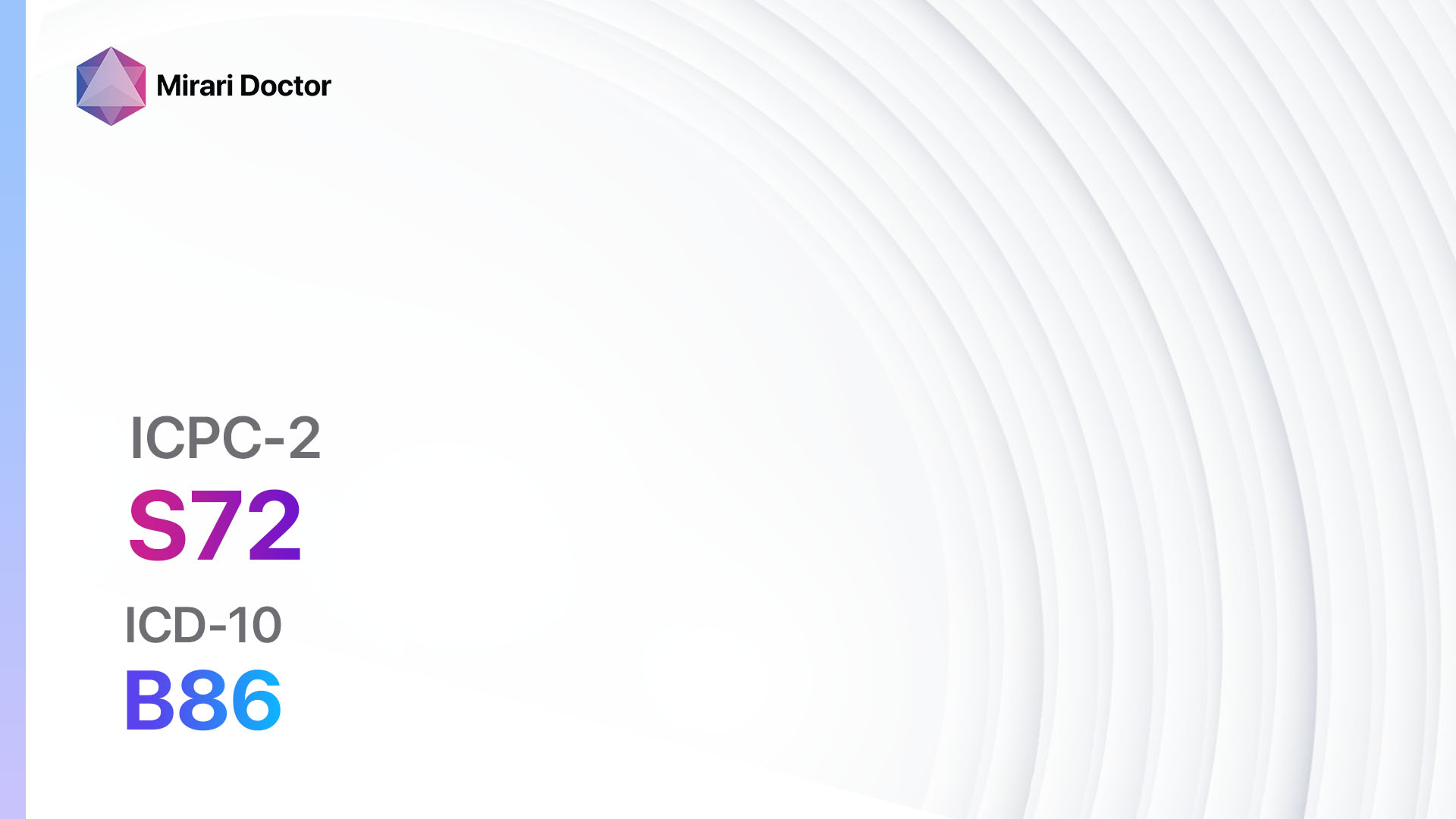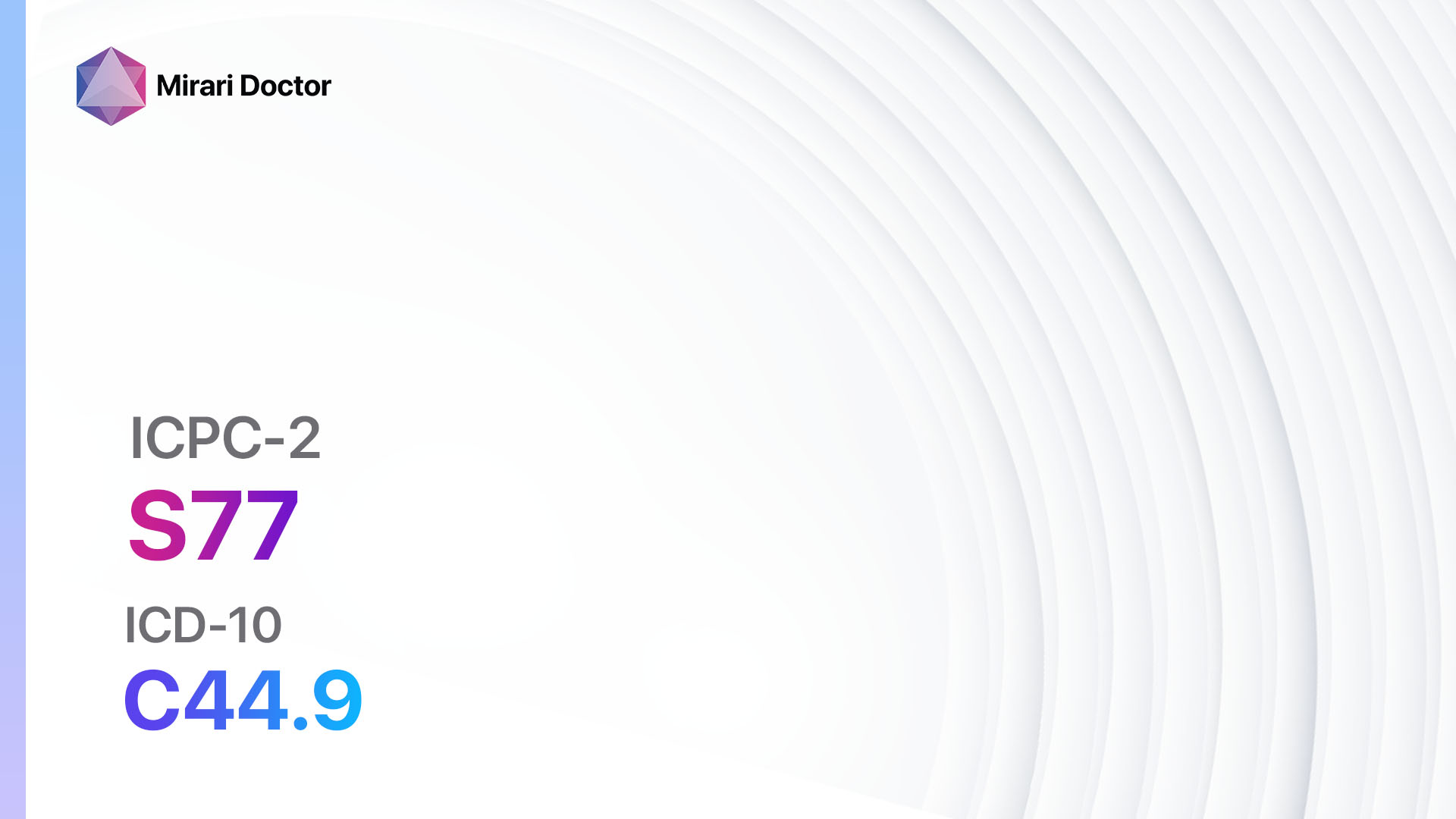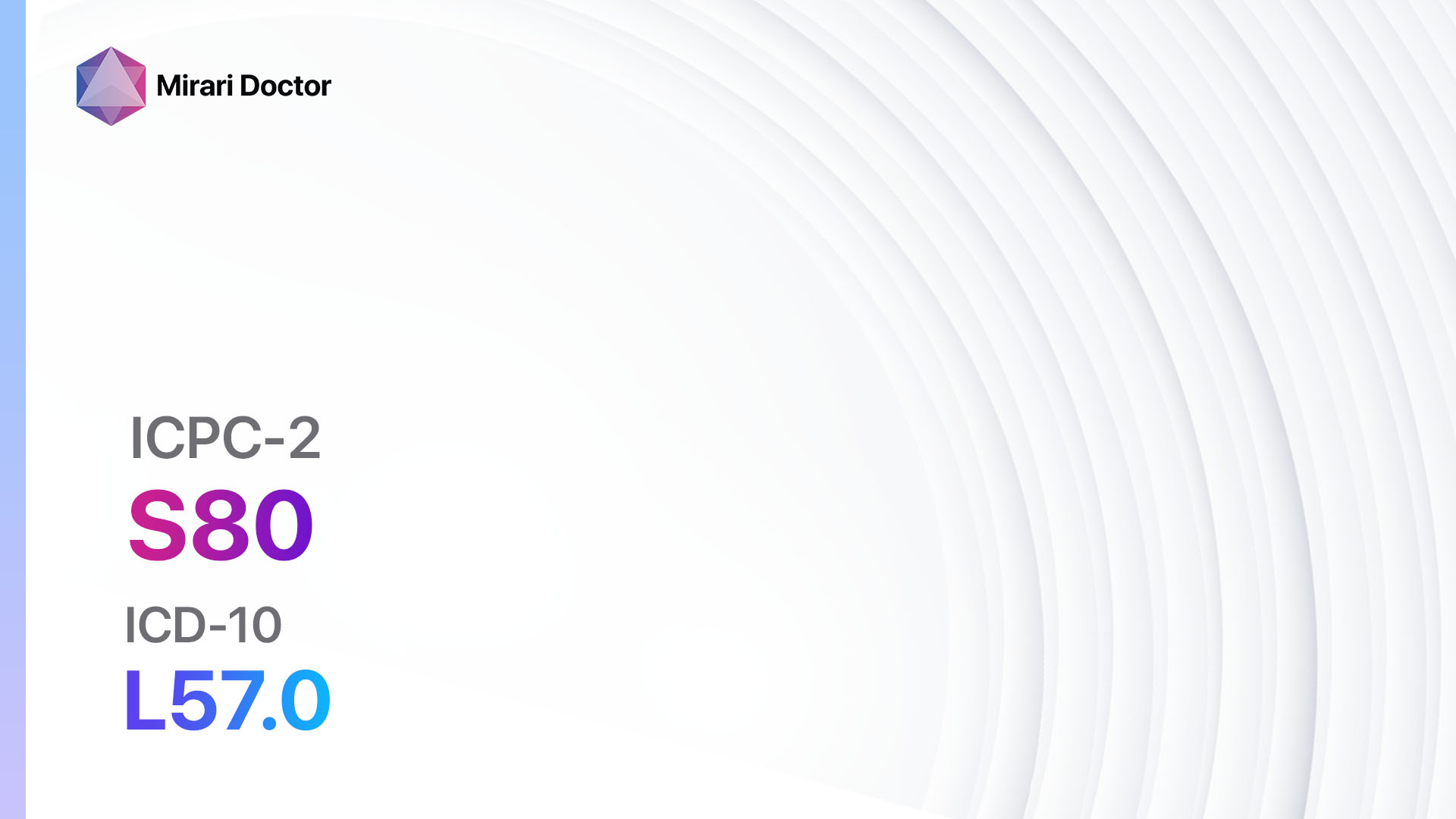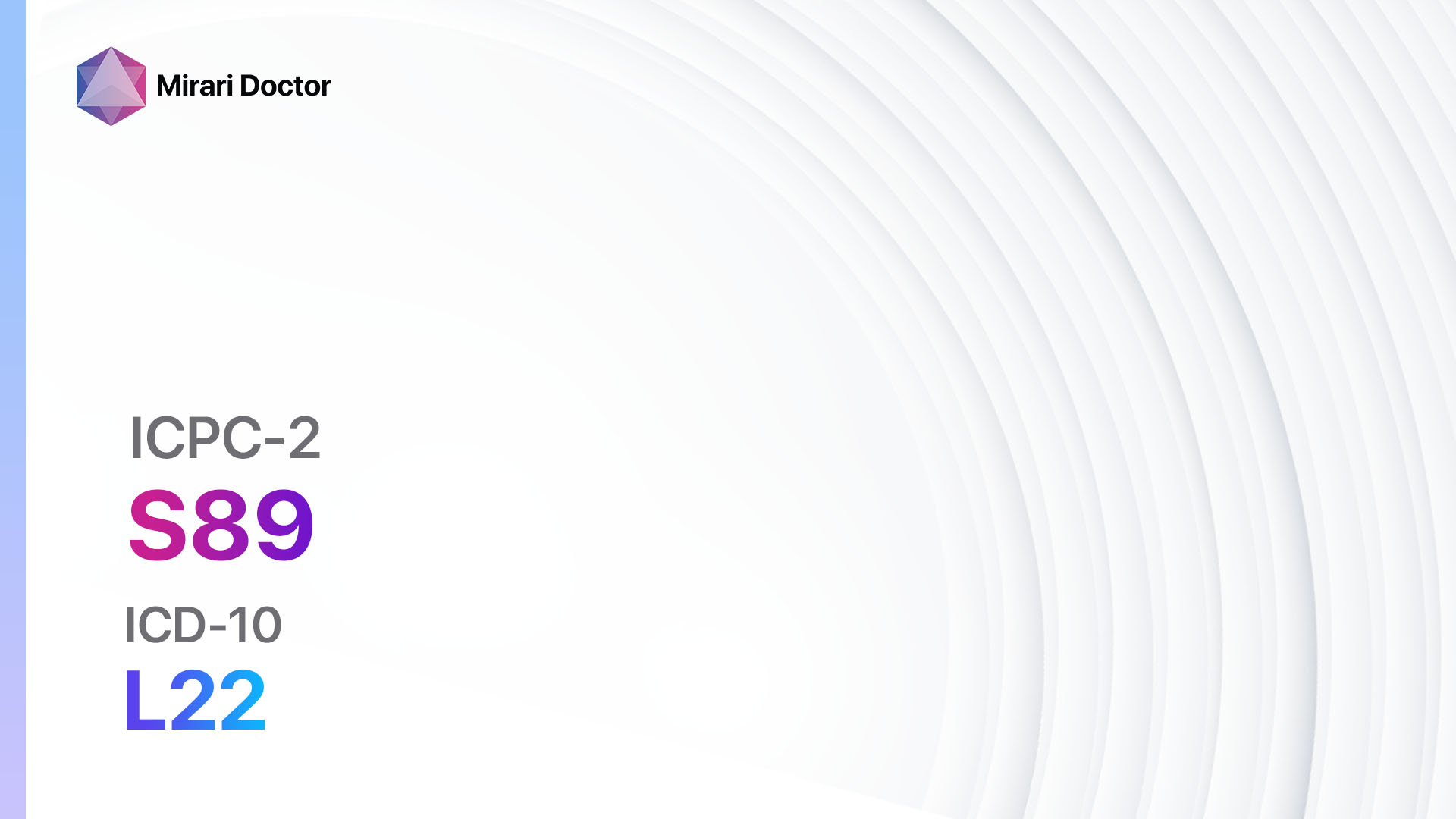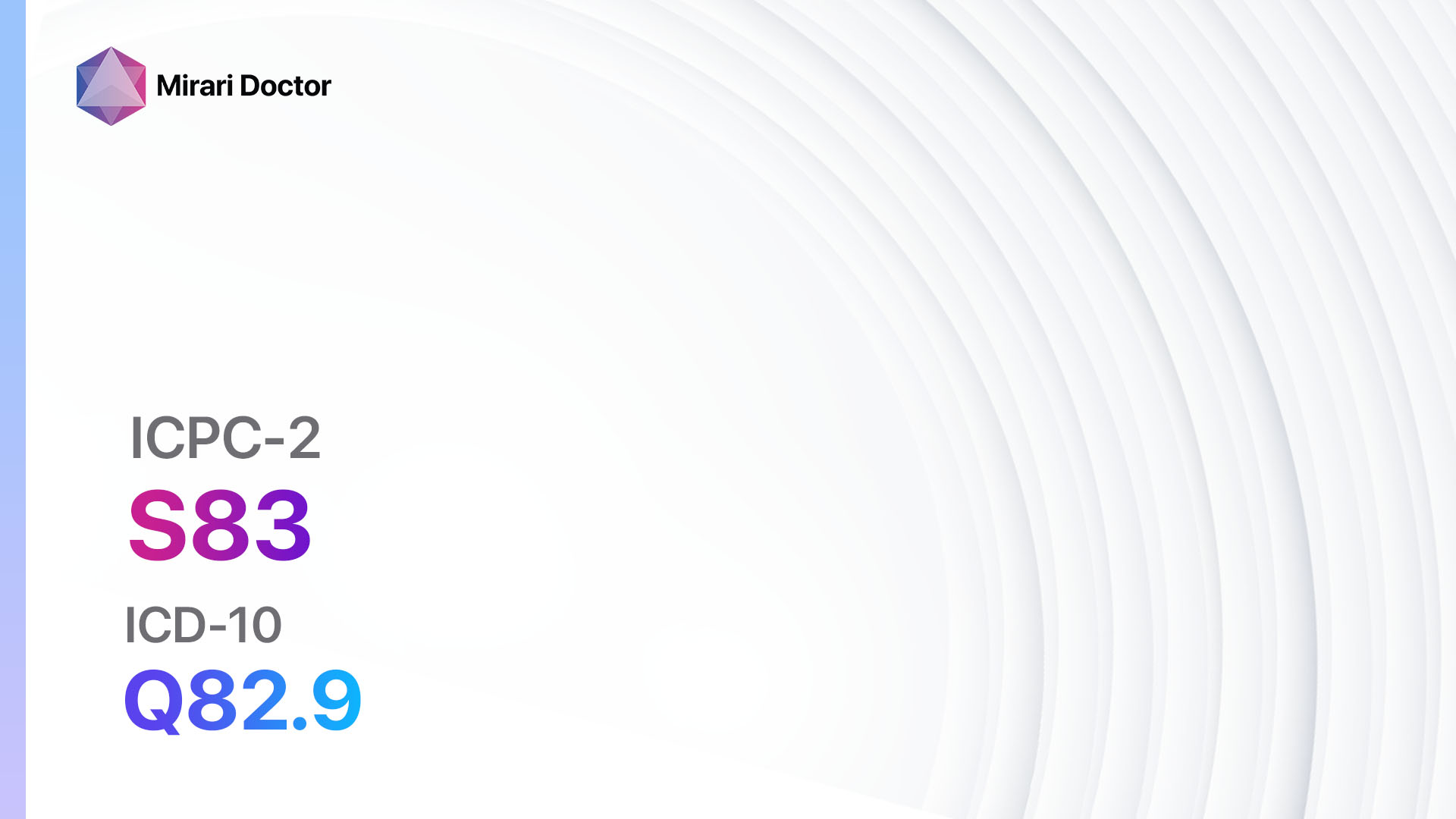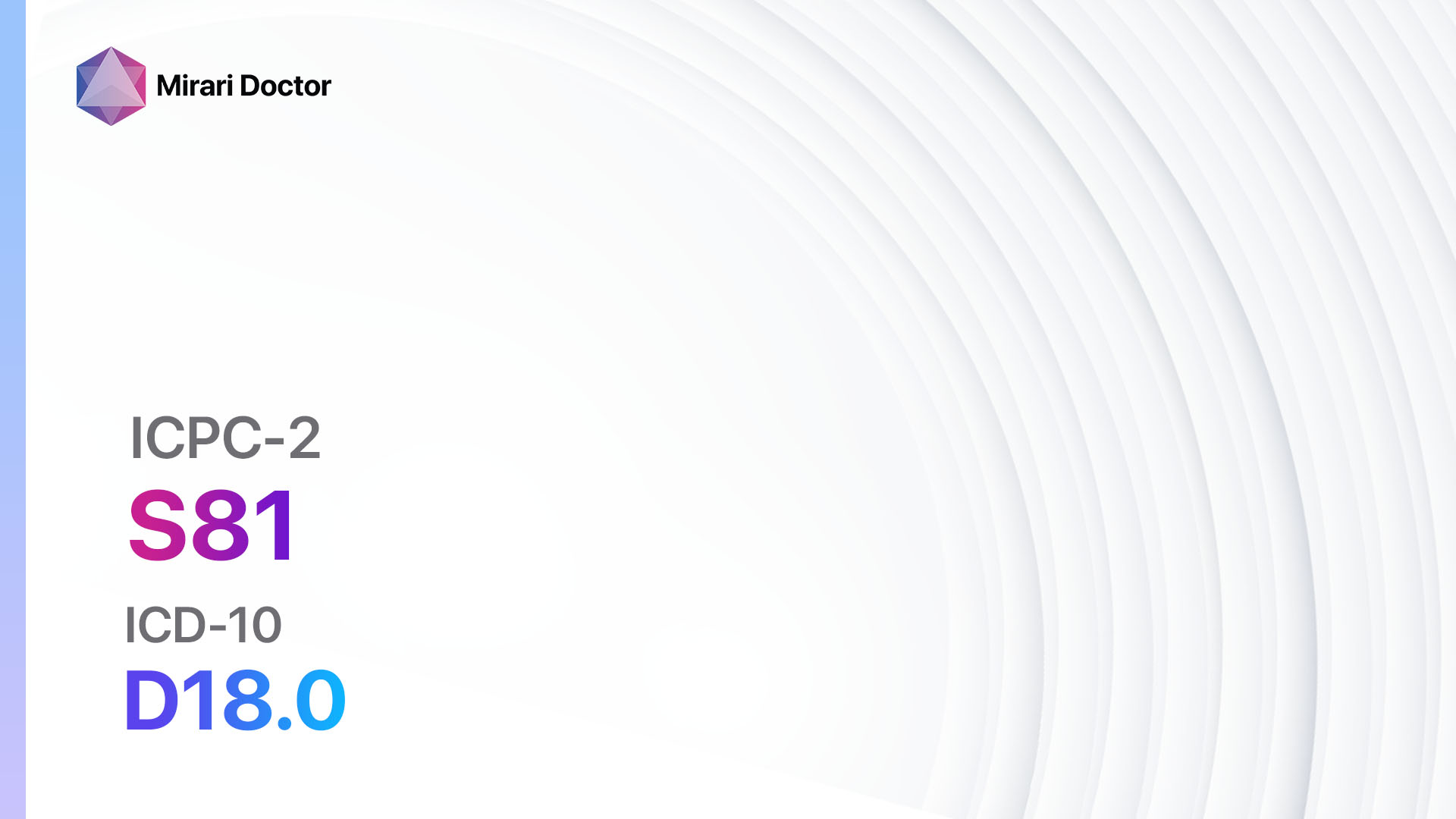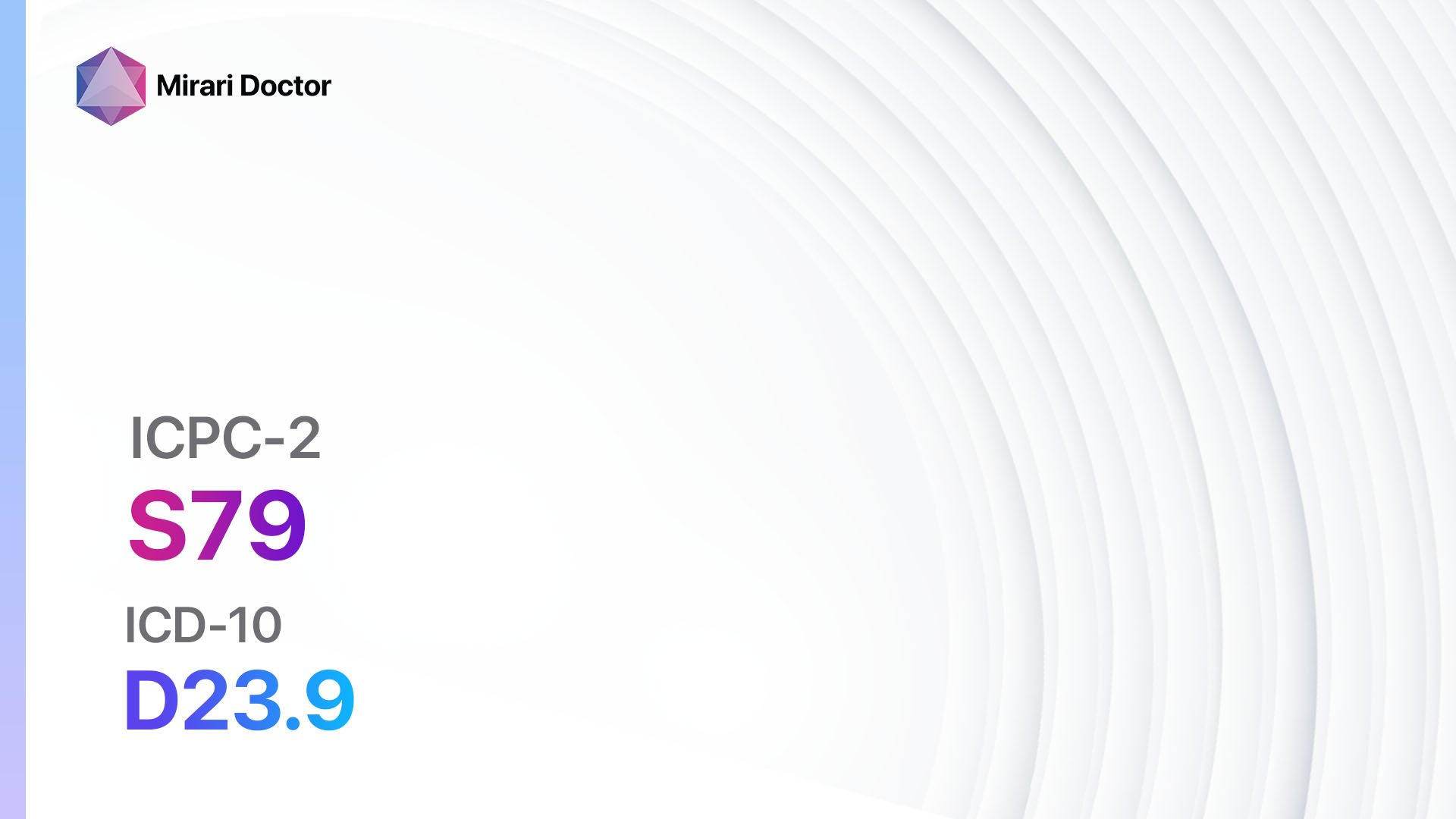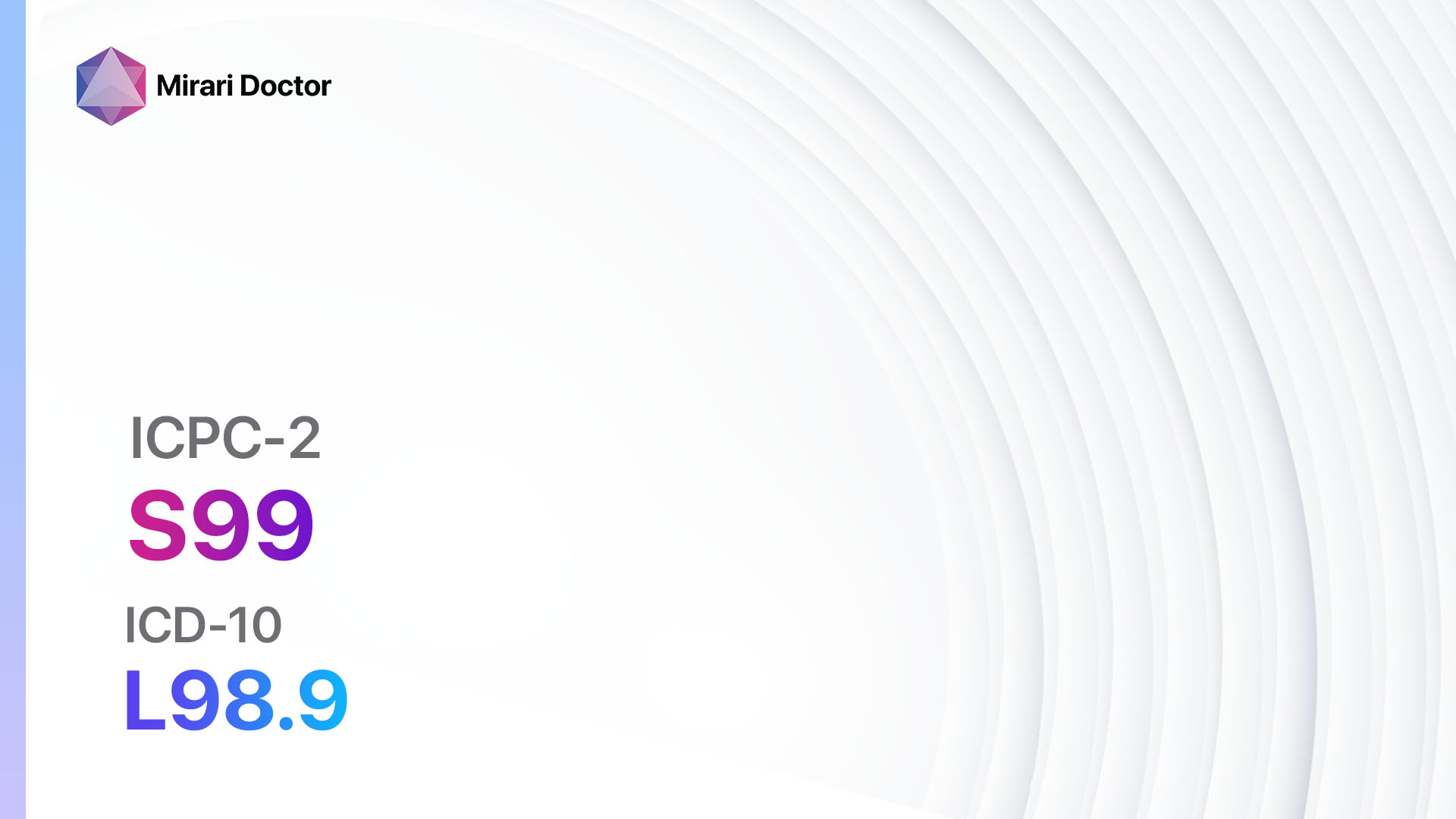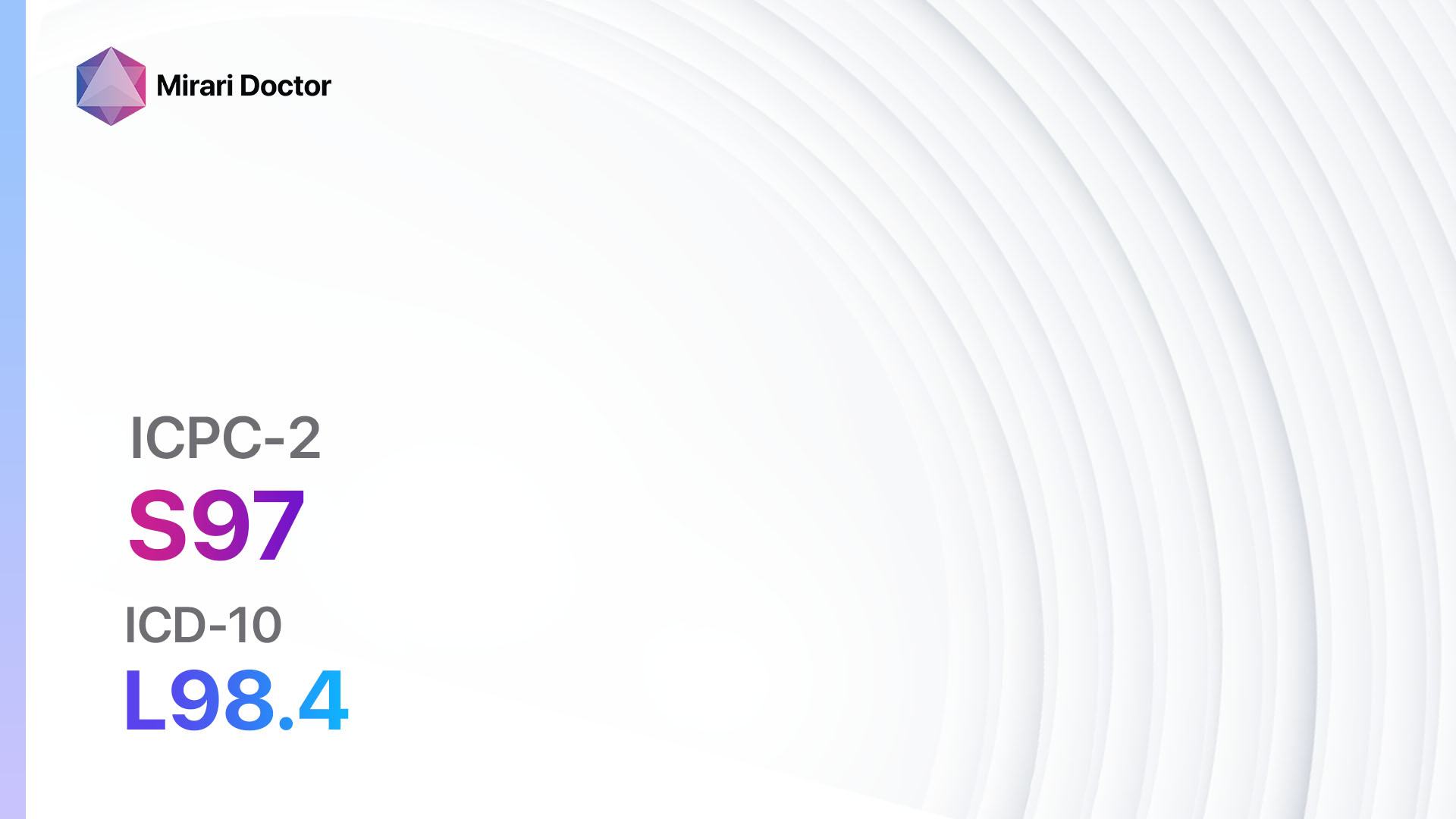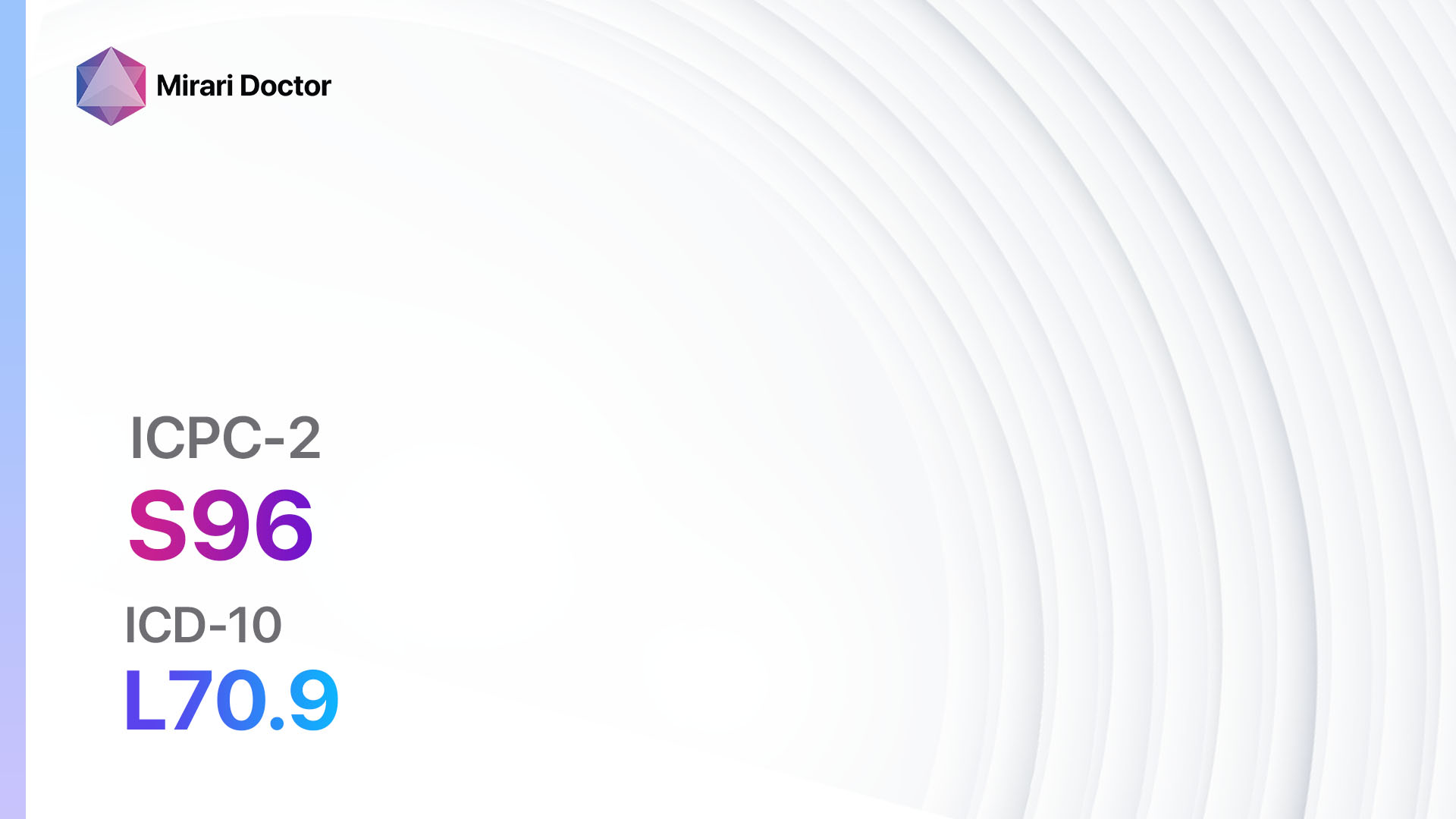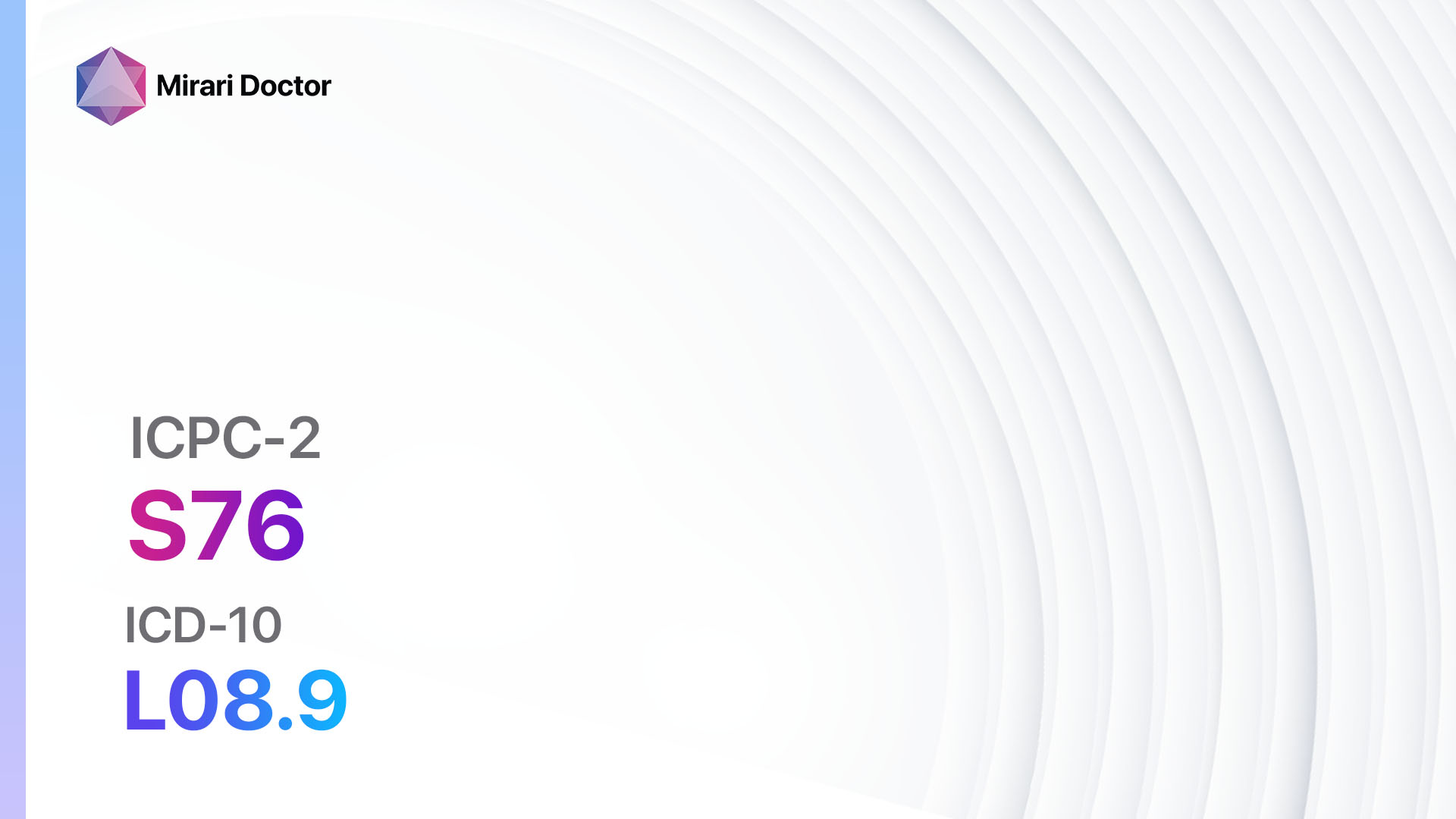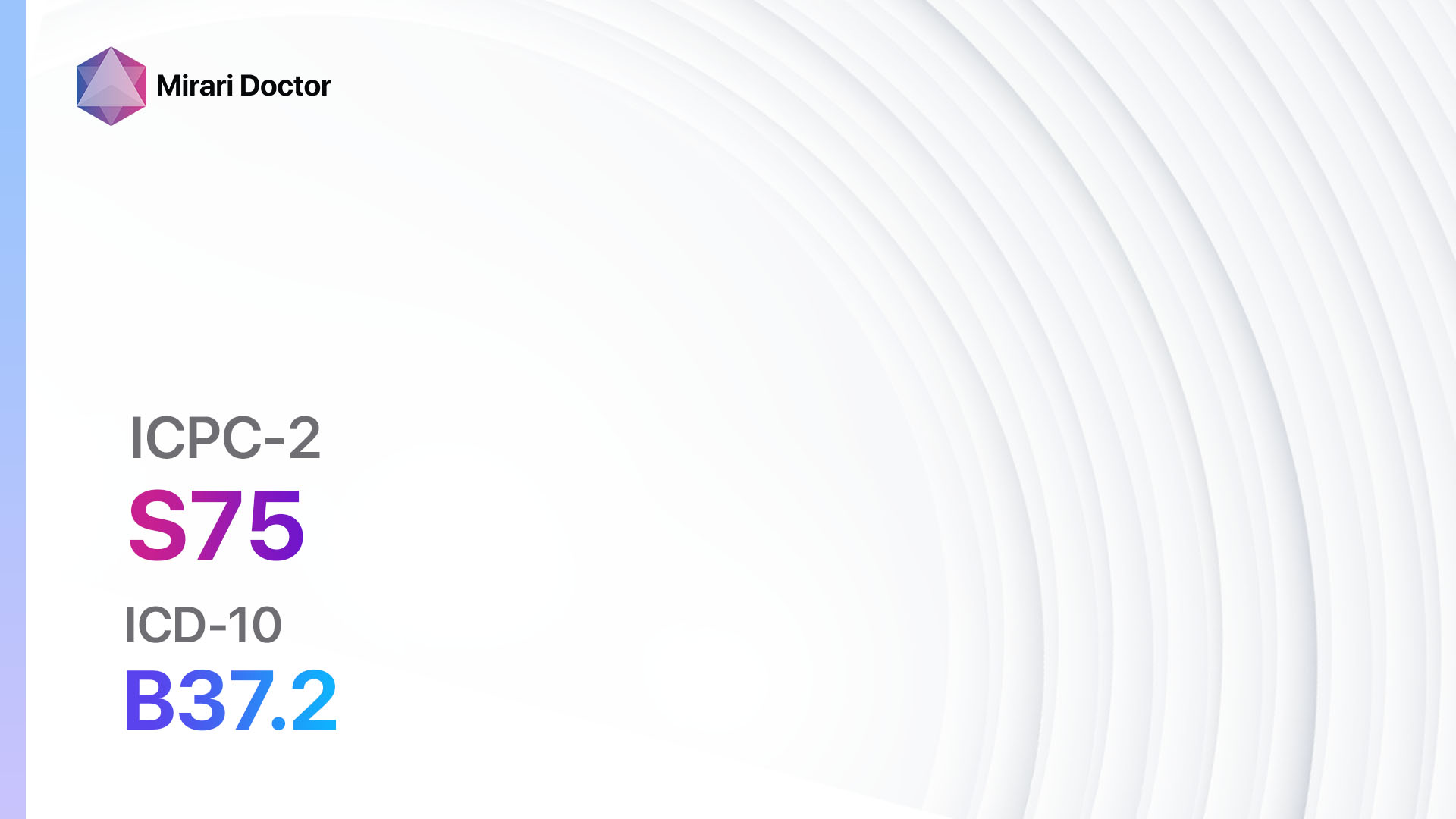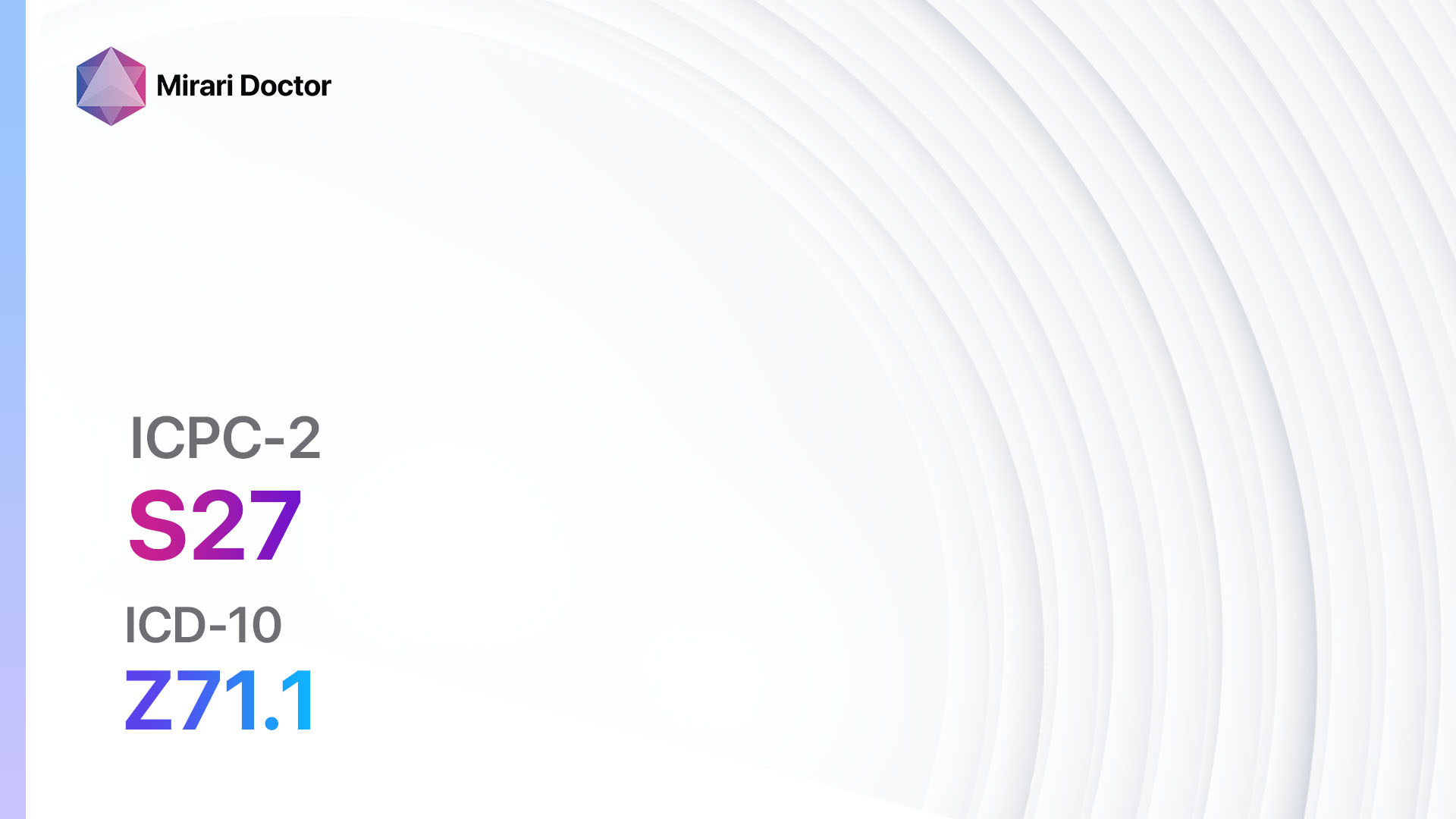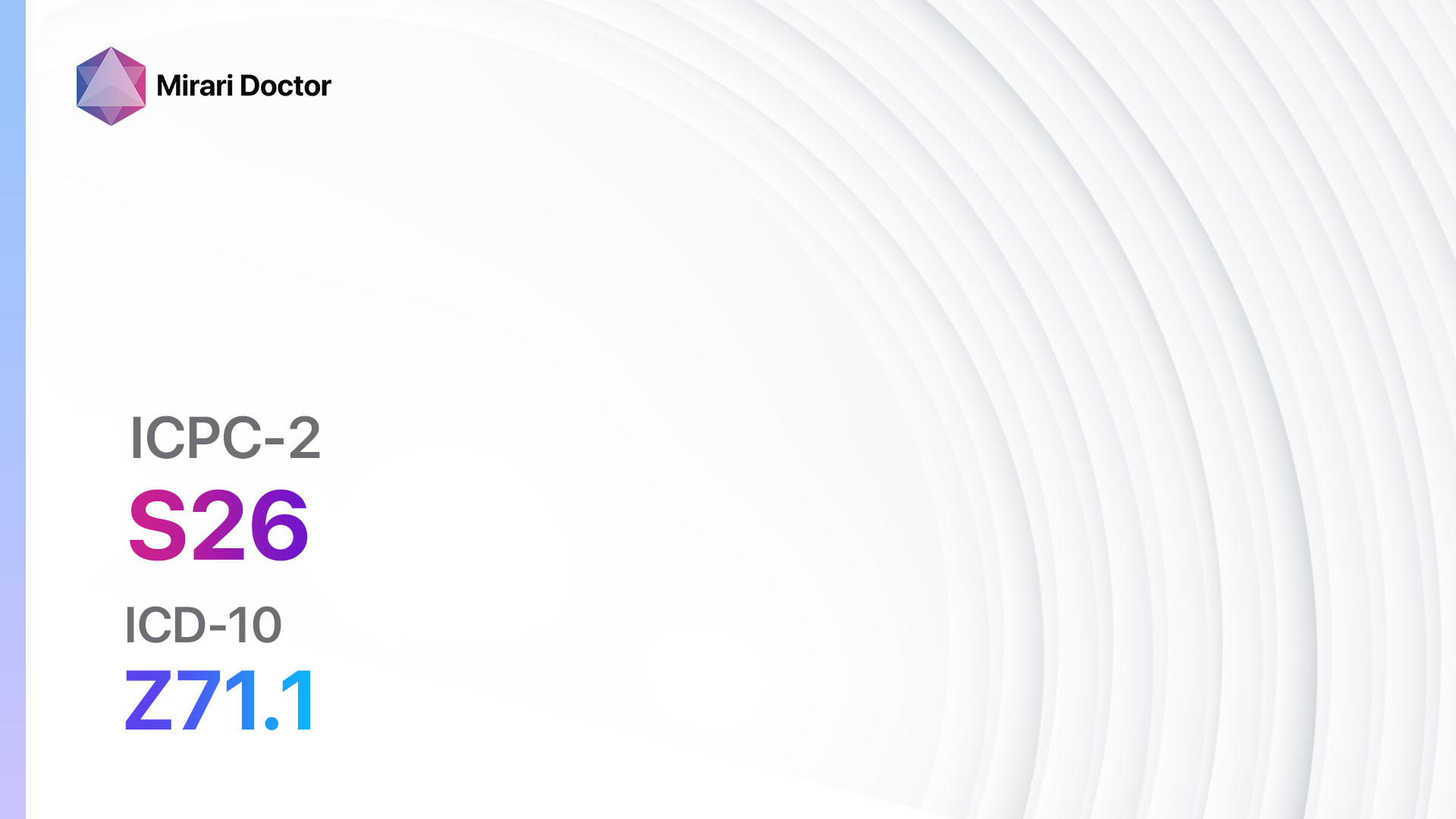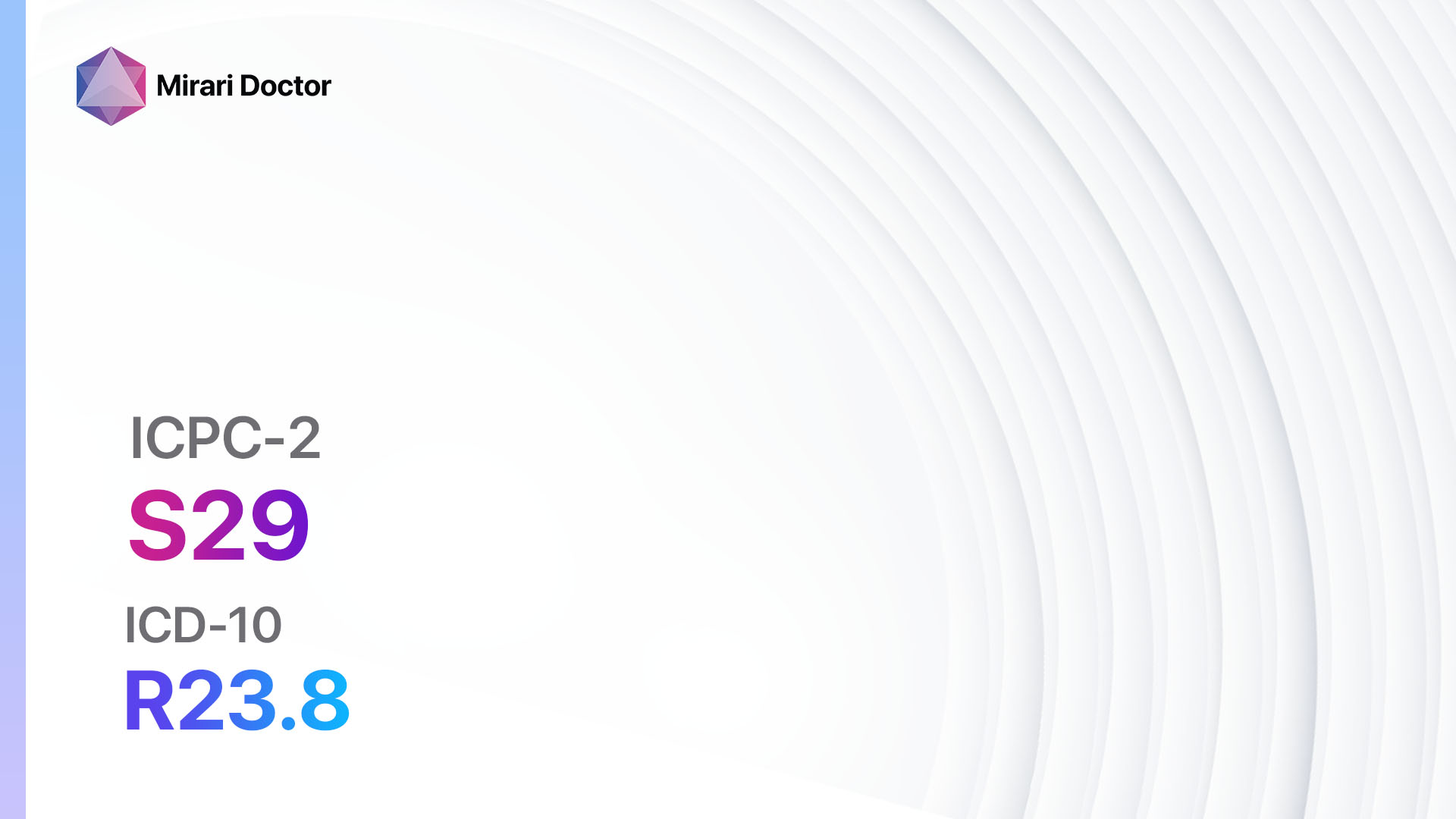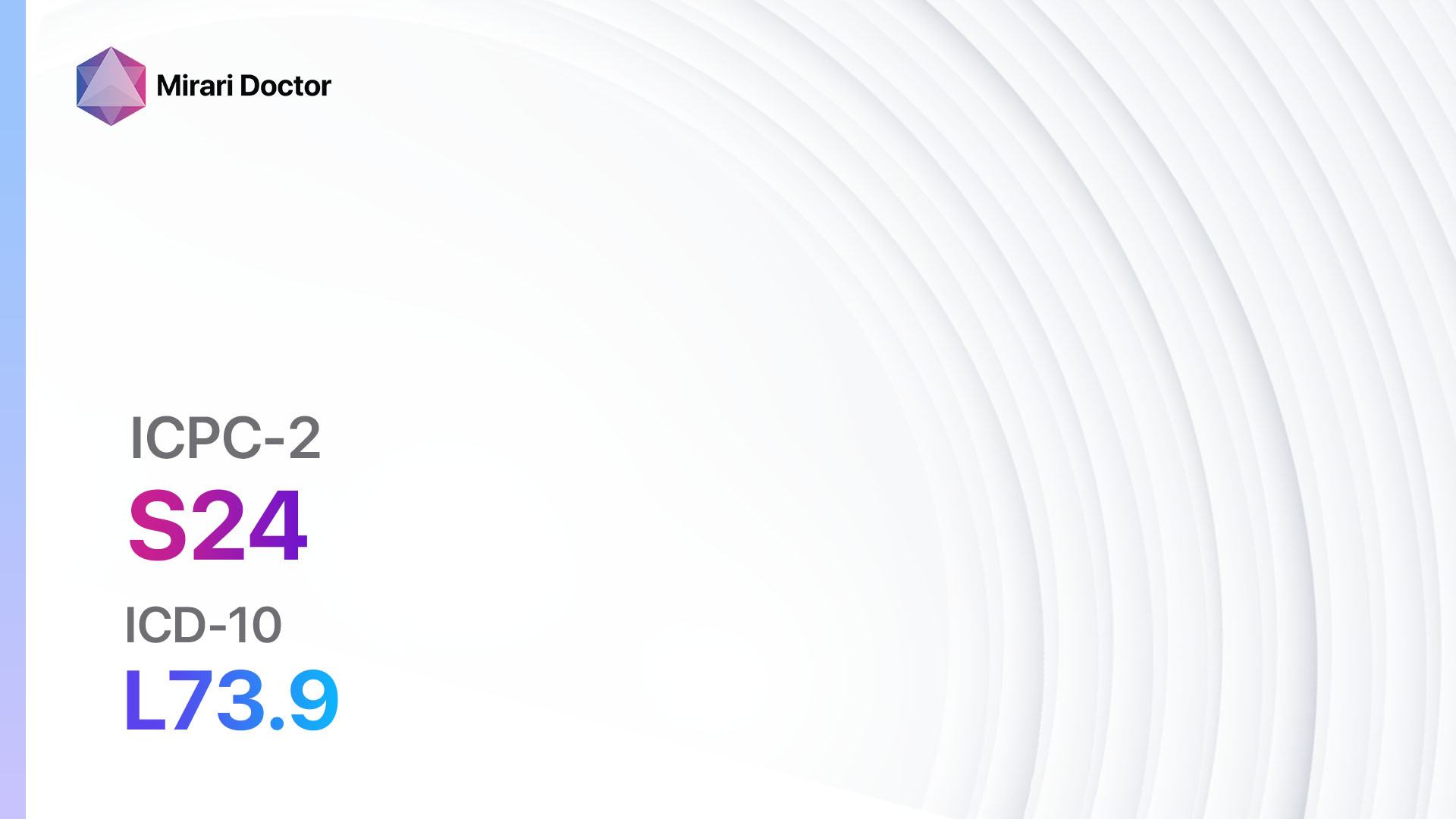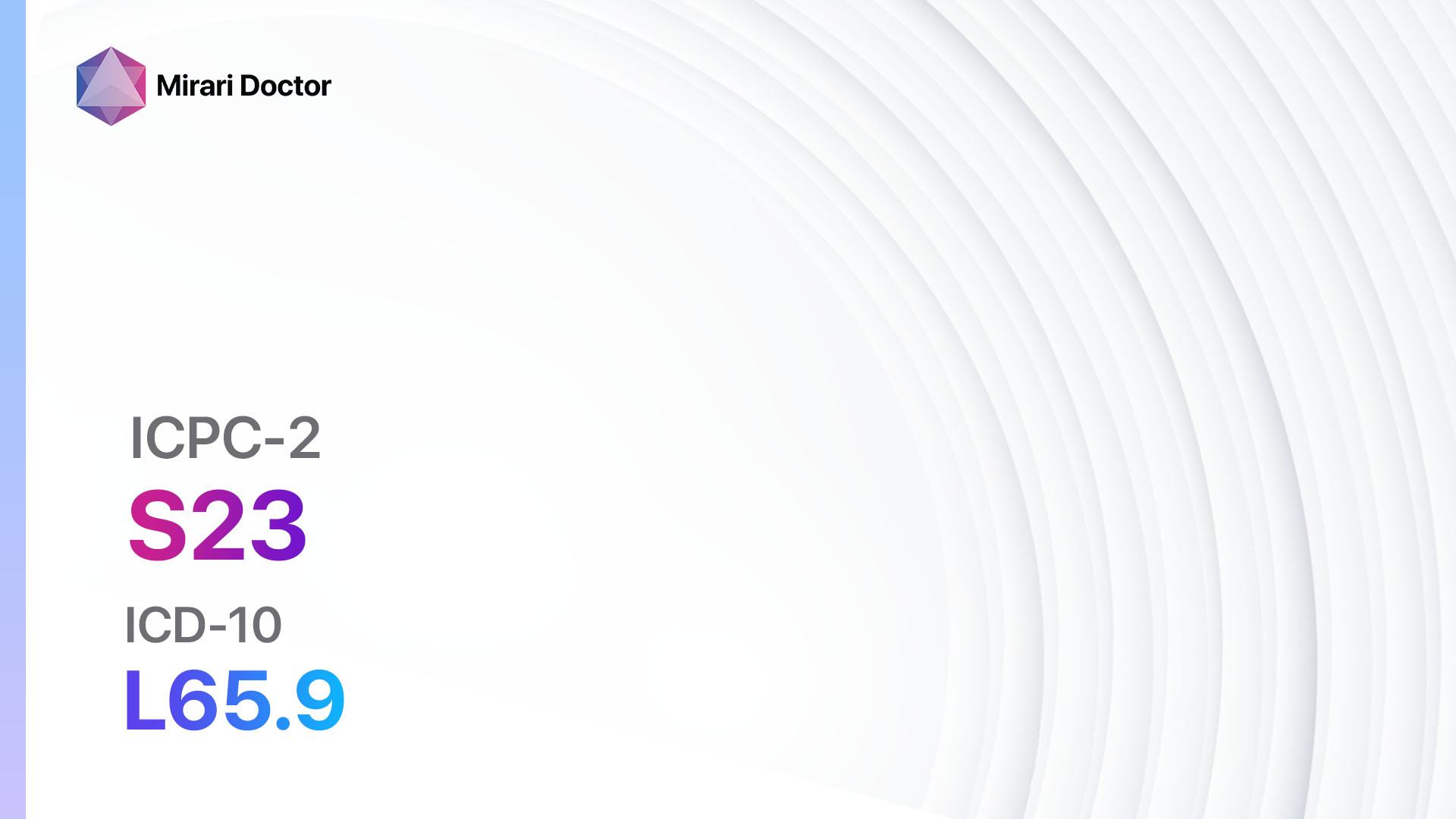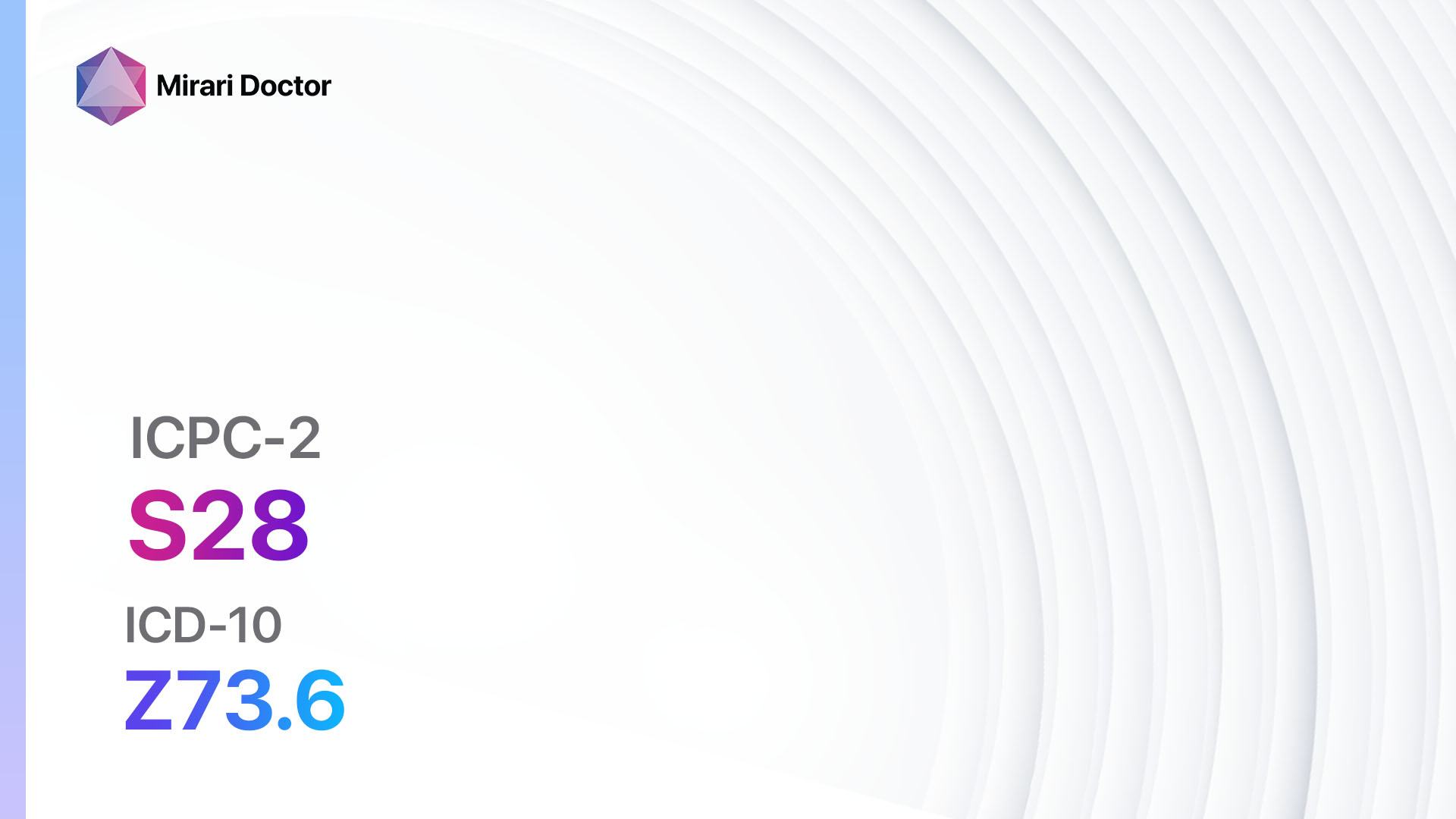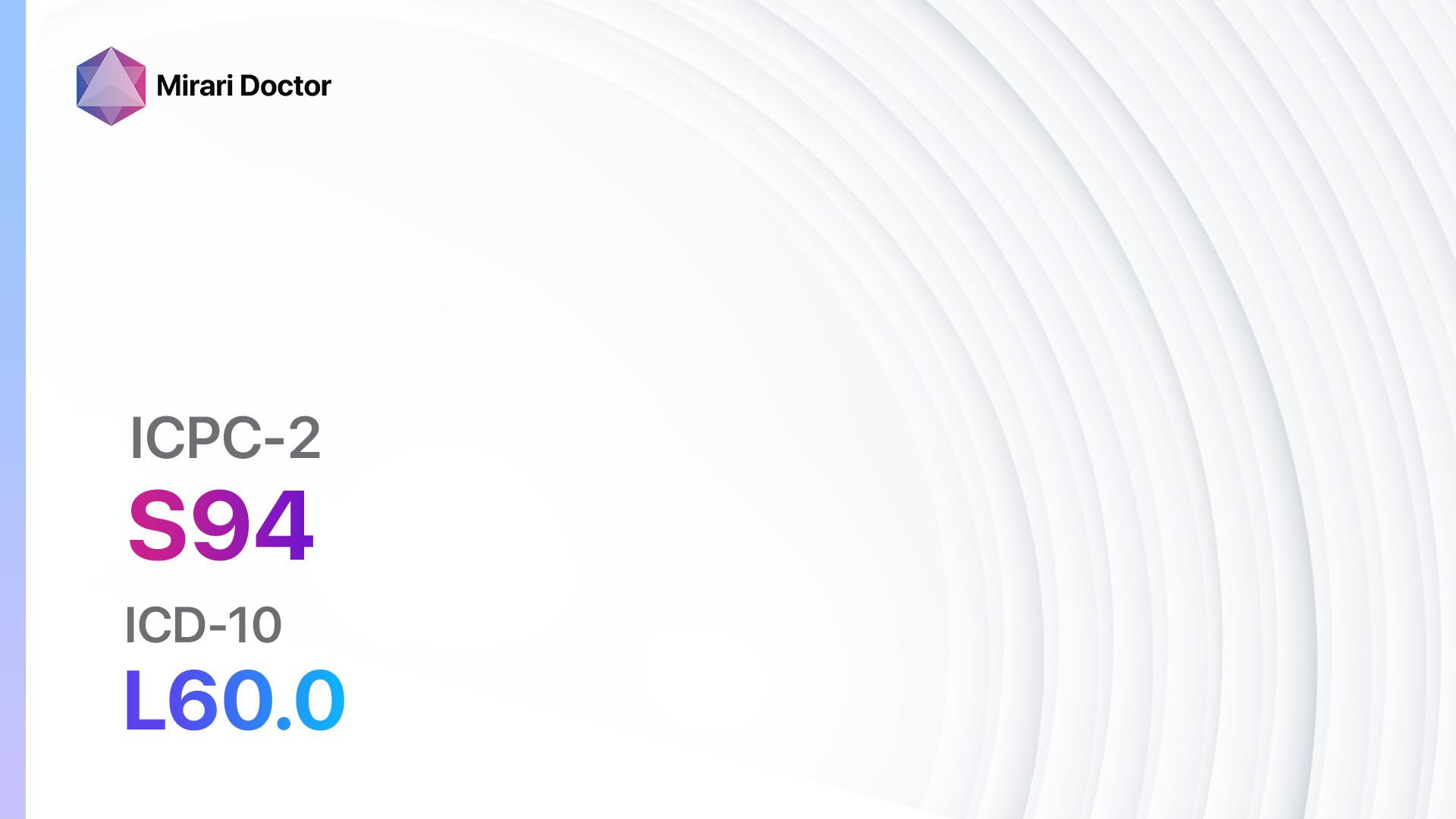
Introduction
Ingrowing nail, also known as onychocryptosis, is a common condition characterized by the growth of the nail into the surrounding skin. This can result in pain, swelling, redness, and infection.[1] The aim of this guide is to provide a comprehensive overview of the symptoms, causes, diagnostic steps, possible interventions, and lifestyle interventions for ingrowing nail.
Codes
Symptoms
- Pain and tenderness along the edge of the nail[2]
- Swelling and redness around the nail[3]
- Formation of a pus-filled blister or abscess[4]
- Difficulty walking or wearing shoes[5]
- Infection, indicated by discharge or foul odor[6]
Causes
- Improper nail trimming, such as cutting the nail too short or rounding the edges[7]
- Tight-fitting shoes or socks that put pressure on the toes[8]
- Trauma or injury to the nail[9]
- Genetic predisposition to ingrowing nails[10]
- Fungal or bacterial infection of the nail
Diagnostic Steps
Medical History
- Inquire about the patient’s nail care routine and any recent changes in nail trimming techniques
- Ask about the patient’s footwear choices and whether they wear tight-fitting shoes or socks
- Assess for any history of trauma or injury to the affected nail
- Determine if the patient has a family history of ingrowing nails
- Inquire about any signs of infection, such as discharge or foul odor
Physical Examination
- Inspect the affected nail for signs of ingrowing, such as redness, swelling, or pus
- Palpate the area around the nail to assess for tenderness and pain
- Evaluate the patient’s gait and ability to walk comfortably
- Look for signs of infection, such as warmth, red streaks, or lymph node enlargement
Determine Severity
- Grade 1: Mild ingrowing nail with minimal pain and inflammation
- Grade 2: Moderate ingrowing nail with increased pain, swelling, and redness
- Grade 3: Severe ingrowing nail with significant pain, infection, and difficulty walking
Laboratory Tests
- No specific laboratory tests are required for the diagnosis of ingrowing nail.
Diagnostic Imaging
- No diagnostic imaging is necessary for the diagnosis of ingrowing nail.
Other Tests
- No other diagnostic tests are necessary for the diagnosis of ingrowing nail.
Follow-up and Patient Education
- Advise the patient to follow up if symptoms worsen or if signs of infection develop
- Educate the patient on proper nail care techniques, including trimming the nails straight across and avoiding cutting them too short
- Encourage the patient to wear comfortable, properly fitting shoes and socks
- Discuss the importance of maintaining good foot hygiene and keeping the feet clean and dry
Possible Interventions
Traditional Interventions
Medications:
Top 5 drugs for Ingrowing nail:
- Oral antibiotics (e.g., Amoxicillin, Cephalexin):
- Cost: Generic versions can be $3-$50/month.
- Contraindications: Allergy to penicillin or cephalosporins.
- Side effects: Upset stomach, diarrhea, rash.
- Severe side effects: Severe allergic reactions, Clostridium difficile infection.
- Drug interactions: Warfarin, methotrexate.
- Warning: Finish the full course of antibiotics as prescribed.
- Topical antibiotics (e.g., Neomycin, Bacitracin):
- Cost: Over-the-counter options are available for <$10.
- Contraindications: Allergy to neomycin or bacitracin.
- Side effects: Skin irritation, rash.
- Severe side effects: Allergic reactions.
- Drug interactions: None reported.
- Warning: Apply as directed and avoid using on open wounds.
- Topical antifungals (e.g., Clotrimazole, Miconazole):
- Cost: Over-the-counter options are available for <$10.
- Contraindications: Allergy to clotrimazole or miconazole.
- Side effects: Skin irritation, rash.
- Severe side effects: Allergic reactions.
- Drug interactions: None reported.
- Warning: Apply as directed and continue treatment for the recommended duration.
- Oral analgesics (e.g., Acetaminophen, Ibuprofen):
- Cost: Over-the-counter options are available for <$10.
- Contraindications: Allergy to acetaminophen or NSAIDs, active gastrointestinal bleeding.
- Side effects: Upset stomach, liver damage (with acetaminophen), stomach ulcers (with NSAIDs).
- Severe side effects: Severe allergic reactions, liver failure (with acetaminophen), gastrointestinal bleeding (with NSAIDs).
- Drug interactions: Warfarin, aspirin.
- Warning: Follow the recommended dosage and avoid exceeding the maximum daily dose.
- Oral corticosteroids (e.g., Prednisone, Methylprednisolone):
- Cost: Generic versions can be $10-$50/month.
- Contraindications: Active infections, systemic fungal infections.
- Side effects: Increased appetite, weight gain, mood changes.
- Severe side effects: Increased risk of infections, osteoporosis, adrenal suppression.
- Drug interactions: NSAIDs, anticoagulants.
- Warning: Use for short durations and taper off gradually to avoid withdrawal symptoms.
Alternative Drugs:
- Topical analgesics (e.g., Lidocaine gel): Provides temporary pain relief.
- Oral antifungals (e.g., Fluconazole): Used if fungal infection is suspected.
- Oral nonsteroidal anti-inflammatory drugs (NSAIDs) (e.g., Naproxen): Helps reduce pain and inflammation.
- Topical corticosteroids (e.g., Hydrocortisone cream): May help reduce inflammation and itching.
- Oral antihistamines (e.g., Diphenhydramine): Can help relieve itching and promote sleep.
Surgical Procedures:
- Partial nail avulsion: Removal of a portion of the nail and the underlying nail bed to prevent further ingrowing. Cost: $500-$1500.
- Total nail avulsion: Complete removal of the nail and the underlying nail bed to allow for regrowth. Cost: $1000-$2000.
- Matrixectomy: Removal of the nail matrix to prevent future nail regrowth. Cost: $1500-$3000.
Alternative Interventions
- Warm water soaks: Soaking the affected foot in warm water with Epsom salt can help reduce pain and inflammation. Cost: <$10.
- Elevation: Elevating the affected foot can help reduce swelling. Cost: Free.
- Toe braces: Applying a toe brace or splint can help straighten the nail and prevent ingrowing. Cost: $10-$20.
- Cotton ball placement: Placing a small piece of cotton under the ingrowing nail can help lift it away from the skin. Cost: <$5.
- Tea tree oil: Applying diluted tea tree oil to the affected area may have antimicrobial properties. Cost: $5-$10.
Lifestyle Interventions
- Proper nail care: Educate the patient on the importance of trimming the nails straight across and avoiding cutting them too short. Cost: Free.
- Comfortable footwear: Encourage the patient to wear properly fitting shoes and socks to reduce pressure on the toes. Cost: Varies.
- Good foot hygiene: Emphasize the need to keep the feet clean and dry to prevent infection. Cost: Varies.
- Weight management: Advise the patient to maintain a healthy weight to reduce pressure on the toes. Cost: Varies.
- Regular exercise: Promote regular exercise to improve circulation and overall foot health. Cost: Varies.
It is important to note that the cost ranges provided are approximate and may vary depending on the location and availability of the interventions.
Mirari Cold Plasma Alternative Intervention
Understanding Mirari Cold Plasma
- Safe and Non-Invasive Treatment: Mirari Cold Plasma is a safe and non-invasive treatment option for various skin conditions. It does not require incisions, minimizing the risk of scarring, bleeding, or tissue damage.
- Efficient Extraction of Foreign Bodies: Mirari Cold Plasma facilitates the removal of foreign bodies from the skin by degrading and dissociating organic matter, allowing easier access and extraction.
- Pain Reduction and Comfort: Mirari Cold Plasma has a local analgesic effect, providing pain relief during the treatment, making it more comfortable for the patient.
- Reduced Risk of Infection: Mirari Cold Plasma has antimicrobial properties, effectively killing bacteria and reducing the risk of infection.
- Accelerated Healing and Minimal Scarring: Mirari Cold Plasma stimulates wound healing and tissue regeneration, reducing healing time and minimizing the formation of scars.
Mirari Cold Plasma Prescription
Video instructions for using Mirari Cold Plasma Device – S94 Ingrowing nail (ICD-10:L60.0)
| Mild | Moderate | Severe |
| Mode setting: 1 (Infection) Location: 0 (Localized) Morning: 15 minutes, Evening: 15 minutes |
Mode setting: 1 (Infection) Location: 0 (Localized) Morning: 30 minutes, Lunch: 30 minutes, Evening: 30 minutes |
Mode setting: 1 (Infection) Location: 0 (Localized) Morning: 30 minutes, Lunch: 30 minutes, Evening: 30 minutes |
| Mode setting: 2 (Wound Healing) Location: 0 (Localized) Morning: 15 minutes, Evening: 15 minutes |
Mode setting: 2 (Wound Healing) Location: 0 (Localized) Morning: 30 minutes, Lunch: 30 minutes, Evening: 30 minutes |
Mode setting: 2 (Wound Healing) Location: 0 (Localized) Morning: 30 minutes, Lunch: 30 minutes, Evening: 30 minutes |
| Mode setting: 10 (Dermatitis/Fungus) Location: 0 (Localized) Morning: 15 minutes, Evening: 15 minutes |
Mode setting: 10 (Dermatitis/Fungus) Location: 0 (Localized) Morning: 30 minutes, Lunch: 30 minutes, Evening: 30 minutes |
Mode setting: 10 (Dermatitis/Fungus) Location: 0 (Localized) Morning: 30 minutes, Lunch: 30 minutes, Evening: 30 minutes |
| Total Morning: 45 minutes approx. $7.50 USD, Evening: 45 minutes approx. $7.50 USD |
Total Morning: 90 minutes approx. $15 USD, Lunch: 90 minutes approx. $15 USD, Evening: 90 minutes approx. $15 USD |
Total Morning: 90 minutes approx. $15 USD, Lunch: 90 minutes approx. $15 USD, Evening: 90 minutes approx. $15 USD |
| Usual treatment for 7-60 days approx. $105 USD – $900 USD | Usual treatment for 6-8 weeks approx. $1,890 USD – $2,520 USD | Usual treatment for 3-6 months approx. $4,050 USD – $8,100 USD |
 |
|
Use the Mirari Cold Plasma device to treat Ingrowing nail effectively.
WARNING: MIRARI COLD PLASMA IS DESIGNED FOR THE HUMAN BODY WITHOUT ANY ARTIFICIAL OR THIRD PARTY PRODUCTS. USE OF OTHER PRODUCTS IN COMBINATION WITH MIRARI COLD PLASMA MAY CAUSE UNPREDICTABLE EFFECTS, HARM OR INJURY. PLEASE CONSULT A MEDICAL PROFESSIONAL BEFORE COMBINING ANY OTHER PRODUCTS WITH USE OF MIRARI.
Step 1: Cleanse the Skin
- Start by cleaning the affected area of the skin with a gentle cleanser or mild soap and water. Gently pat the area dry with a clean towel.
Step 2: Prepare the Mirari Cold Plasma device
- Ensure that the Mirari Cold Plasma device is fully charged or has fresh batteries as per the manufacturer’s instructions. Make sure the device is clean and in good working condition.
- Switch on the Mirari device using the power button or by following the specific instructions provided with the device.
- Some Mirari devices may have adjustable settings for intensity or treatment duration. Follow the manufacturer’s instructions to select the appropriate settings based on your needs and the recommended guidelines.
Step 3: Apply the Device
- Place the Mirari device in direct contact with the affected area of the skin. Gently glide or hold the device over the skin surface, ensuring even coverage of the area experiencing.
- Slowly move the Mirari device in a circular motion or follow a specific pattern as indicated in the user manual. This helps ensure thorough treatment coverage.
Step 4: Monitor and Assess:
- Keep track of your progress and evaluate the effectiveness of the Mirari device in managing your Ingrowing nail. If you have any concerns or notice any adverse reactions, consult with your health care professional.
Note
This guide is for informational purposes only and should not replace the advice of a medical professional. Always consult with your healthcare provider or a qualified medical professional for personal advice, diagnosis, or treatment. Do not solely rely on the information presented here for decisions about your health. Use of this information is at your own risk. The authors of this guide, nor any associated entities or platforms, are not responsible for any potential adverse effects or outcomes based on the content.
Mirari Cold Plasma System Disclaimer
- Purpose: The Mirari Cold Plasma System is a Class 2 medical device designed for use by trained healthcare professionals. It is registered for use in Thailand and Vietnam. It is not intended for use outside of these locations.
- Informational Use: The content and information provided with the device are for educational and informational purposes only. They are not a substitute for professional medical advice or care.
- Variable Outcomes: While the device is approved for specific uses, individual outcomes can differ. We do not assert or guarantee specific medical outcomes.
- Consultation: Prior to utilizing the device or making decisions based on its content, it is essential to consult with a Certified Mirari Tele-Therapist and your medical healthcare provider regarding specific protocols.
- Liability: By using this device, users are acknowledging and accepting all potential risks. Neither the manufacturer nor the distributor will be held accountable for any adverse reactions, injuries, or damages stemming from its use.
- Geographical Availability: This device has received approval for designated purposes by the Thai and Vietnam FDA. As of now, outside of Thailand and Vietnam, the Mirari Cold Plasma System is not available for purchase or use.
References
- Khunger N, Kandhari R. Ingrown toenails. Indian J Dermatol Venereol Leprol. 2012;78(3):279-289.
- Heidelbaugh JJ, Lee H. Management of the ingrown toenail. Am Fam Physician. 2009;79(4):303-308.
- Mayeaux EJ Jr, Carter C, Murphy TE. Ingrown Toenail Management. Am Fam Physician. 2019;100(3):158-164.
- Eekhof JA, Van Wijk B, Knuistingh Neven A, van der Wouden JC. Interventions for ingrowing toenails. Cochrane Database Syst Rev. 2012;(4):CD001541.
- DeLauro NM, DeLauro TM. Onychocryptosis. Clin Podiatr Med Surg. 2004;21(4):617-630.
- Woo SH, Kim IH. Surgical pearl: nail edge separation with dental floss for ingrown toenails. J Am Acad Dermatol. 2004;50(6):939-940.
- Baran R, Haneke E. Etiology and treatment of nail malalignment. Dermatol Surg. 1998;24(7):719-721.
- Langford DT, Burke C, Robertson K. Risk factors in onychocryptosis. Br J Surg. 1989;76(1):45-48.
- Pearson HJ, Bury RN, Wapples J, Watkin DF. Ingrowing toenails: is there a nail abnormality? A prospective study. J Bone Joint Surg Br. 1987;69(5):840-842.
- Gunal I, Kosay C, Veziroglu A, Balkan Y, Ilhan F. Relationship between onychocryptosis and foot type and treatment with toe spacer. A preliminary investigation. J Am Podiatr Med Assoc. 2003;93(1):33-36.
Related articles
Made in USA


